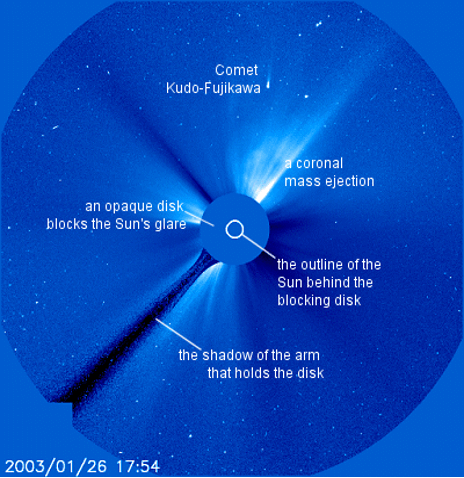A coronal mass ejection blast and subsequent impact at Earth (Not to scale). Credit: NASA/GSFC/SOHO/ESA
What is a coronagraph?
A coronagraph is used to block out the direct light from a star so that nearby objects – which otherwise would be hidden in the star’s brightness– can be observed. This process can be thought of as an artificial solar eclipse. This sophisticated instrument enables scientific exploration of the corona by revealing its intricate features through effectively suppressing the bright light from the photosphere.


Science, design and function
A coronagraph detects the corona by isolating the wavelengths around a coronal emission line when the intense light from the photosphere (the solar surface) is blocked.
It employs a meticulously-crafted refracting telescope (as reflecting telescopes scatter too much light) with precise lenses to prevent scattering of intense sunlight and preserve only the faint corona. A carefully positioned disk blocks sunlight around the central object, ensuring the corona remains the dominant visible feature. Internal diaphragm stops minimise reflections from scattered light within the coronagraph. A secondary telescope captures the unobscured corona’s light for analysis using a photographic plate or eyepiece. Filters optimize performance and correct chromatic aberrations (when the lens fails to focus all colours to the same point due to dispersion).
Coronagraphs operating within Earth’s atmosphere have the disadvantage of observing light that has already been scattered in the sky, primarily due to Rayleigh scattering (scattering of light by particles much smaller than the light’s wavelength) of sunlight in the upper atmosphere. Therefore, the sites for coronagraph observations must be high above the Earth’s atmosphere with minimal dust in the sky.

The factors which distinguish coronal light, and the sky brightness, are highlighted in the following table.
| Coronal Light | Sky Brightness |
|---|---|
| Thomson-scattered (scattering of radiation by charged particles) at ~90°. | Scattered at only a glancing angle. |
| Undergoes scattering polarisation (restriction of the direction of orientation of light). | Nearly unpolarised. |
Types of coronagraphs
Ground-based coronagraphs
There are various types of ground-based coronagraphs:
- band-limited coronagraphs – which use a mask to block light and other associated diffraction effects,
- phase-mask coronagraphs -which implement a transparent mark that phase shifts the light so that it has self-destructive interference,
- optical vortex coronagraphs – use a similar mask where the shift varies azimuthally around the coronagraph centre.
Satellite-based coronagraphs
Satellite-based coronagraphs are much more effective than ground-based ones because of the absence of atmospheric scattering. These study the outer reaches of the solar corona and perform coronagraphy by employing a wide-range of techniques – from the use of near-infrared cameras to mid-infrared instruments. The real-time coronal imagery allows for forecasters to predict the beginning, strength, and duration of a geomagnetic storm and possible disruptions of electronic equipment on Earth.
Stellar coronagraphs
Most solar coronagraphs are intended to view the corona of the Sun. However now, stellar (as opposed to solar) coronagraphs are being used to find extra-solar planets and circumstellar disks around nearby stars, as well as host galaxies in quasars and similar objects with active galactic nuclei (AGN). This is quite difficult compared to solar coronagraphs, since they differ by a factor of a million in their apparent size. Therefore, to achieve such a contrast requires extreme optothermal stability (the rate at which the optical element distorts due to changing thermal environment).
On ground-based telescopes, a stellar coronagraph can be combined with adaptive optics to search for planets around nearby stars.
Thus, coronagraphs prove to be vital both in understanding the science of the Sun, and in the search for extrasolar planets.
Further reading
SpaceWeather.com, What is a Coronagraph?, (Accessed: 30th June 2023)
NASA, American Museum of Natural History, Humans create the first artificial solar eclipse to study the corona, (Accessed: 30th June 2023)
NOIRLab/NSF/AURA, Sacramento Peak Observatory in New Mexico, NOIRLab, (Accessed: 30th June 2023)
Max Waldmeier, Coronagraph – Astrophysical Observatory, Arosa, (Accessed: 30th June 2023)
Pascalou Petit (2007), Pic du Midi Observatory (France), (Accessed: 30th June 2023)
Gnevyshev, M. N., Nikolsky, G. M., & Sazanov, A. A, Solar Physics, Volume 2, Issue 2, pp.223-226, (1967), The Lyot-Coronagraph with 53cm Objective, (Accessed: 30th June 2023)
Norikura Solar Observatory (2009), (Accessed: 30th June 2023)
Kuchner, M.J. and Traub, W.A., 2002. A coronagraph with a band-limited mask for finding terrestrial planets.The Astrophysical Journal, 570(2), p.900.
National Ocean Service (2022), Studying the Corona, (Accessed: 30th June 2023)